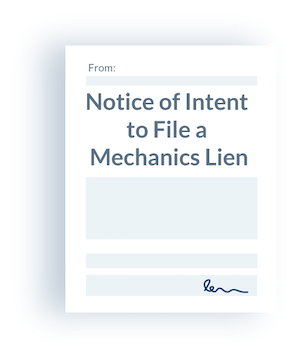
Mechanics liens make an impact. A lien can put the general contractor and other higher-tiered participants in hot water with the owner, can freeze project funds, and at the very least, will grab the attention of the other “up-the-chain” parties on the project. When a lien is filed, it shows you mean business and that you won’t take nonpayment as an option. Plus, a firm deadline is put on resolving the claim. By drawing a line in the sand, a claimant takes control of the situation and says, “If I’m not paid by X date, this lien will be foreclosed.” But how do liens affect relationships? (No, we’re not talking about mechanics liens and breakups, though we’ve done that before…). We’re talking here about how a lien claim affects your industry relationships.
If the act of filing the lien doesn’t prompt payment on its own, then a claimant may send one final warning in the form of a Notice of Intent to Foreclose. And of course, foreclosing the lien is still on the table (but be sure to mind your deadlines).
Good Communication Is the Key to a Good Relationship
The act of filing a mechanics lien will not, in itself, ruin a relationship. Every project is different, relationships will vary depending on countless factors involved, and some people will just be patently unreasonable. Having said that, communication is the key to building strong relationships. By building the relationship through clear and effective communication, many payment problems on a project can be resolved before ever having to file a lien.
However, if a problem persists and a lien is necessary, there are other steps before foreclosure is in order. Ultimately, the more communication that occurs before a lien is filed the better – surprising an owner or GC with a lien is a surefire way to burn some bridges.
Use Notices to Build the Relationship
Sending preliminary notice is a prerequisite to preserving lien rights in many states, but notice should be sent even when it’s not required. We’ve got lots of material on how relationships can be built and maintained through sending notice. The basic gist of it is this: Sending notice promotes visibility on the project, and contractors should be ecstatic when they receive them.
Mechanics liens don’t only affect property owners – often a GC will be bound (by law or by contract) to defend a lien claim or to bond off liens that arise. GC’s have a vested interest in avoiding serious payment issues, and the first step to preventing a lien is having a thorough understanding of the payment chain for a particular project.
Notice of Intent to Lien
We’ve skipped a few steps to this point, but if you’re reading this post you’re probably already having problems receiving payment (plus, who likes long blog posts?) – let’s talk about sending a Notice of Intent to Lien. Notice of Intent to Lien is required in some states, but like preliminary notice, sending this notice even when it’s not required can save many headaches.
Slow payment currently comes with the territory in construction, and we understand that it’s not always avoidable. However, most experienced construction industry members can tell when payments are slowed due to the nature of the game or if they’re indicative of a larger problem. Either way – sending a Notice of Intent to Lien will show that you mean business, and it will also be easier (and cheaper!) than filing a lien. As the cherry on top, up the chain parties will likely appreciate having one last chance to resolve the dispute before a lien is filed. Where Notice of Intent to Lien is voluntary, think of it as a final pre-lien courtesy.
Your relationship includes your mechanics lien process
When it’s time to file the lien, is the owner, GC, and/or developer going to hate you for it? Well, they probably won’t be happy. Then again, they’re the ones dropping the ball on making payment. It’s also important to keep in mind that mechanics lien deadlines are strict, and promises of payment won’t do anything to extend a deadline. If you miss your chance to file the lien, the remedy will be unavailable moving forward and you’ll lose your best leverage to get paid.
Communicate about your plan to file
Anyway, the best way to anger someone with a lien is to have it pop up out of nowhere. This is where the first two sections of the article can help – if notices have been sent and all parties have been in constant communication, the owner won’t be blindsided. That won’t totally eliminate the pain of a lien, but it should soften the blow. Also, when communicating about the lien (either before or after it’s filed – or both), letting an owner know that the lien will be immediately released upon a resolution of the dispute should go a long way to calm their nerves.
Send notice that the lien was filed
This part is simple – send notice that the lien was filed!
Many states require such notice, but even when not required, you should let the owner and GC know that a lien claim has been filed. On one hand, it will prevent the lien claim from catching them off guard. On the other hand, it’s beneficial to the claimant. Foreclosing the lien is something neither side wants to do, so giving the other side a heads up that the lien was filed will allow for more time to resolve the lien claim.
Mechanics liens and credit reports
Another question we’ve gotten a lot recently is, “How will a mechanics lien affect an owner’s credit score?”
The mere act of filing a lien won’t have a crippling affect on the owner’s credit, and it may have no effect on their report at all. But it’s possible. Ultimately, just about anything in public record can affect credit. Now, if the bill is passed along to collections or if the lien is foreclosed, this would almost certainly result in a negative mark against an owner’s credit report.
Notice of Intent to Foreclose
When recovering payment, foreclosing a lien should be the last resort. Mechanics liens can be filed in virtually every state without initiating a lawsuit, but to foreclose the lien, you’ll have to go to court. Litigation can be scary and expensive, but it’s even scarier (and potentially much more expensive) for an owner. Thus, even where payment issues have been unreconcilable, giving an owner one last chance at payment is a fruitful exercise – so send a Notice of Intent to Foreclose. It’s one final courtesy call showing that you mean business, and as an optional document, the Notice of Intent to Foreclose should be (relatively) welcomed by those who receive it – it’s better than just finding out the lien was foreclosed!
Preserve Your Mechanics Lien Rights – And Your Relationships
It’s important to keep in mind that, if you’ve followed the mechanics lien process, you’ve been communicating with the non-paying party throughout the project. Building a strong relationship with your customers should include communicating about your credit policy. Be clear and direct about your payment expectations. If your lien filing deadline approaches, you’ve likely been waiting to get paid for months. Your customer should fully expect you to file a lien, because you’ve been up front with them that you’re serious about getting paid.
Every relationship, whether personal or professional, is a two-way street. No matter how much I tweet at Beyoncé, she and I don’t have a relationship. If you’re working with a GC or property owner that isn’t doing a good job of communicating with you – much less paying you – then you don’t have a relationship to preserve.
Protecting your payments is about preserving your relationships with the most important people of all: the people you work with. If a customer is not paying you, it’s your responsibility to your employees and coworkers to protect your business’ livelihood.

